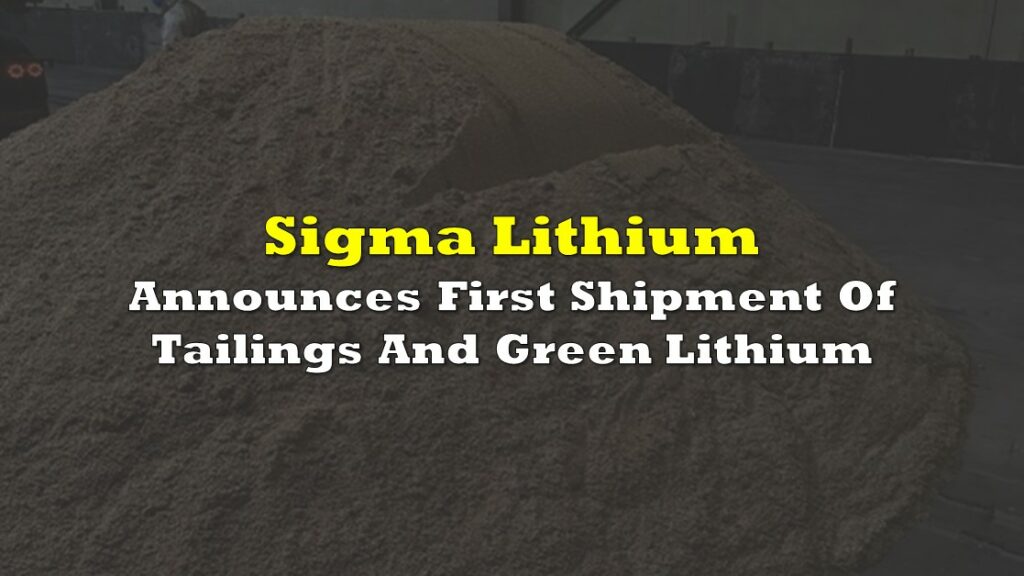Sigma Lithium (TSXV: SGML), a prominent name in the lithium market, has witnessed a significant decline in its shares, plunging more than 14% yesterday alone, echoing the broader trend of turmoil in the electric vehicle (EV) supply chain.
Year-to-date, the company’s shares have fallen more than 52%, coinciding with the decline of spodumene concentrate prices. Also known simply as spodumene, the mineral product is derived from spodumene ore, which is a primary source of lithium. Spodumene is a lithium-aluminum silicate mineral that is commonly found in pegmatite deposits around the world.
Spodumene concentrate typically contains a high concentration of lithium oxide (Li2O), making it a valuable raw material for the production of lithium compounds, particularly lithium carbonate and lithium hydroxide. These lithium compounds are essential components in the manufacturing of lithium-ion batteries, which are widely used in various applications, including electric vehicles, portable electronics, and energy storage systems.

Back in June 2023, the firm released a technical report on the company’s Grota do Cirilo project located in Minas Gerais State, Brazil. In the report’s economic analysis, the project in Phase 1 is expected to generate run-rate production of 270 ktpa of lithium concentrate, delivering US$990 million of annual free cash flow, at a 5.5% spodumene concentrate grade.
The aggregate gross income generated from spodumene concentrate sales is projected to reach US$10.6 billion, based on revenue of US$4,909 per tonne of 5.5% spodumene concentrate. Operating expenses, encompassing royalty fees and trade discounts, amount to US$1.3 billion in total, with an average cost of US$581 per tonne. Consequently, the net profit margin after taxes, factoring in revenue deductions, operational expenditures, and tax obligations, is estimated at US$7.9 billion.
Currently, spodumene concentrate trades at US$938 per tonne, around one fifth of the price the company used in its June 2023 report.

The EV drive loses steam
The catalyst behind the Sigma Lithium downturn also presumably lies in the drastic nosedive of prices for essential materials like lithium and nickel, both vital components of EV batteries.
On Friday, three-month nickel futures closed at $16,235 per tonne on the London Metal Exchange, marking a staggering 50% decline from the end of 2022. This descent culminated in the metal reaching a 32-month low, a stark reminder of the challenges haunting the market. Similarly, lithium carbonate, the global benchmark for lithium, witnessed a free fall to 98,000 yuan ($13,700) per tonne, plummeting over 80% from its 2022 year-end value, with January marking a low not seen in nearly two and a half years.
The roots of these downturns are deeply intertwined with the softening demand in China, the world’s largest EV manufacturing hub. Despite a robust 30% increase in the output of new energy vehicles last year, the growth rate has significantly decelerated compared to previous years, indicating a shift towards more moderate expansion, as noted by Li Xuelian, senior analyst at the Marubeni Research Institute.
As demand softens, the market faces the additional challenge of rapidly expanding supply. Countries like Argentina and Indonesia have ramped up lithium and nickel production, respectively, in anticipation of future demand, exacerbating the supply-demand imbalance.
The repercussions of this imbalance are evident across the industry, with some facilities forced to suspend or cease operations altogether. Australian miner BHP announced a temporary halt to parts of its nickel concentrator operation, while Core Lithium suspended operations at one of its lithium projects due to plummeting prices.
Goldman Sachs warned that current prices render a significant portion of class 1 nickel supplies unprofitable, posing a risk to about 5% of unprocessed nickel produced globally. This scenario underscores the fragility of the market and the challenges faced by producers amidst the current price environment.
Beyond lithium and nickel, the broader nonferrous-metal industry is also feeling the heat. Zinc futures fell to a two-month low, with European mineral supplier Nyrstar shutting down a Dutch plant responsible for about 2% of global zinc production capacity for maintenance.
Amidst these challenges, concerns loom over the industry’s ability to swiftly recover. Mines and refineries facing shutdowns encounter obstacles such as labor shortages and equipment issues, potentially leading to supply disruptions and subsequent price spikes.
Looking ahead, market dynamics remain uncertain. While weak demand and subdued expectations of a U.S. rate cut currently weigh on prices, there is potential for perceived tightness in the medium to long term once demand rebounds, cautioned a researcher at Mizuho Bank.
Information for this briefing was found via Nikkei Asia and the sources mentioned. The author has no securities or affiliations related to this organization. Not a recommendation to buy or sell. Always do additional research and consult a professional before purchasing a security. The author holds no licenses.









